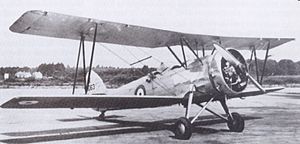Avro Prefect
| Avro 626 | |
|---|---|
 |
|
| Avro Prefect K5063 at Martlesham, July 1935 | |
| Role | General purpose |
| Manufacturer | Avro |
| Designer | Roy Chadwick |
| First flight | 1930 |
| Retired | 1945 |
| Number built | 198 |
| Developed from | Avro 621 |
The Avro 626 is a single-engined British biplane trainer aircraft produced by Avro during the (1918-1939) inter-war period.
The Model 626 was developed by Avro from the company's Model 621 (Tutor) for export to smaller air forces, the idea being that the 626 would be a single aircraft that could carry out general aircrew training as well as a number of other roles. The types 621 and 626 were both two-seaters, but the latter had an additional cockpit behind the rear seat of the 621 and accessible from it. This additional cockpit was fitted with a Scarff ring for a machine gun and carried equipment for air navigation, wireless and gunnery training. Structurally and aerodynamically, it was almost identical to the Tutor: it had a conventional fabric-covered, metal airframe with single-bay wings. Most of the 626s, like the Tutors had an Armstrong Siddeley Lynx IVC engine of 240 hp (180 kW), but most of those supplied to the Egyptian and Brazilian Air Forces used a 260 hp (190 kW) Cheetah V from the same maker.
The usual undercarriage used split, fixed mainwheels and either a tailskid or later a tailwheel, but some 621s appeared on floats and on skis.
The prototype was first flown in 1930.
Avro employed an aggressive sales and marketing effort to introduce the Model 626 to customers throughout the world. An early production demonstration aircraft, marked G-ABFM was sent by sea to South America in 1931. After demonstrations in Buenos Aires and a record-setting flight over the Andes, the aircraft was commandeered by Argentine military officials to help quell a local uprising. The 626 performed so well that an order was immediately placed for 14 additional aircraft. The biggest users were the Air Forces of Chile, Greece, and Portugal. Numerous sales were made to foreign air forces up to 1939, some of which survived in second-line service until 1945.
The 621 was not a civil type, though some did briefly appear on the civil registers of the UK (15) and Hong Kong (6). These markings were worn for testing, demonstration and export; only two civil machines stayed on the prewar U.K.register. After the war, two R.A.F. Prefects were civilianised, as was one in New Zealand.
...
Wikipedia
